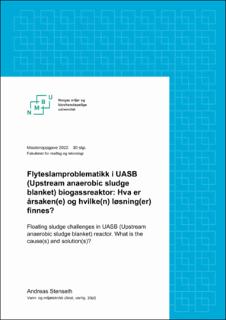| dc.description.abstract | This is a sub-project of via SiEUGreen that will contribute to achieving the goals of creating an urban agriculture with focus on food security, resource efficiency and smarter cities. This will take place in close cooperation between China and the EU. Source separation and greater focus on local treatment of household waste, including wastewater are in focus. Therefore, research is being carried out into a type of UASB (Upstream anaerobic sludge blanket) reactor that treats source-separated black water. This is supplied via water-saving vacuum toilets in a student residence with 24 apartments that can accommodate 48 residents. The goal is to solve challenges associated with this type of reactor and thus work towards the best possible energy balance and reuse of resources in the form of biogas and residues.
In such a reactor, active biomass accumulates over time in the form of sludge on the bottom of the reactor and in a blanket formation upstream. The sludge blanket acts as a filter when particles flow upwards in the reactor and through the sludge blanket. Organic material is broken down in the sludge under anaerobic conditions and energy-rich biogas is formed. In this reactor, the sludge blanket lies on top of the substrate, which limits the efficiency and thus the resource utilization of the black water.
To study the causes, a literature study of similar processes and a number of analyzes have been carried out at the same time as the reactor and the sludge blanket have been monitored. Analyzes have been performed on the ratio between total carbon and nitrogen content (C: N ratio), pH, reduction of organic matter (COD), ammonium concentration, concentration of volatile fatty acids (VFA), the ratio between total content of volatile fatty acids and the buffer capacity of the substrate (FOS/TAC), nutrient analysis of sludge and biogas production, and composition. At the same time, energy- and mass balance have been calculated to study the reactor's efficiency and profitability under current conditions. At the beginning of the trial period, a reduction of hydraulic loading and recycling was done to study the effects. The recycling is essential, as it ensures that the sludge particles in the substrate have a longer average residence time despite a short hydraulic residence time. Excessive recycling causes too much turbulence in the substrate to separate and accumulate enough sludge particles in the upper and lower sludge blankets.
At the beginning of the project, the upper sludge blanket had a clearly high TS visually, which was confirmed by a TS/VS analysis, where TS was approx. 13% and VS% of approx. 93%. The high VS content indicates a high content of active biomass. A reduction in HLR was performed from approx. 35 L/d to approx. 31 L/d, at the same time as the amount of recycling was reduced from 3 to 2 pulses between each substrate feeding with 3 L/pulse on 23 February. The sludge blanket has clearly dissolved gradually until the end of the experimental period on 12 April, at the same time biogas production has increased by approx. 23% from the biogas measurements started until 12 April.
The C:N ratio turns out to be very low, as it was measured to be between approx. 1.5:1 - 4.5:1. Normal for black water is 1:6, while the optimum for a biogas process is somewhere between 16:1 - 35:1. This will therefore be very limiting for the efficiency of this reactor. At the same time, it is also conceivable that the carbon variation is not sufficient for optimal operation, as there is only a single substrate source. Since the majority of nitrogen in black water comes from urine, it is recommended to implement urine separation in the future to increase the C:N ratio to a acceptable level. Urine separation will also provide a significant reduction in ammonium and ammonia in the process, which will further increase efficiency.
The literature study shows that there are many other measures that can be taken to increase the profitability of this reactor. The most important apart from those already mentioned is temperature. The reactor has been operated at a fairly stable temperature of approx. 28℃, while an optimal temperature is in the range 30 - 35 ℃ according to the literature. The average methane production turns out to be 14% lower than theoretically calculated production under current conditions. Temperature and C:N ratios are probably important limiting factors here, but as the daily production continues to increase at the end of the trial period, the adjustment on 23 February will probably still have an ongoing effect. | en_US |

